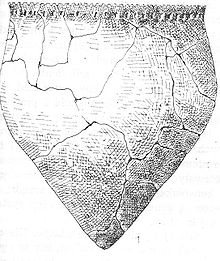Narva culture
| Geographical range | Pit–Comb Ware culture, Corded Ware culture, Brushed Pottery culture |
|---|
| The Mesolithic |
|---|
| ↑ Upper Paleolithic |
| ↓ Neolithic |
The Narva culture or eastern Baltic was a
Technology and artifacts

The people of the Narva culture had little access to flint; therefore, they were forced to trade and conserve their flint resources.[2] For example, there were very few flint arrowheads and flint was often reused. The Narva culture relied on local materials (bone, horn, schist). As evidence of trade, researchers found pieces of pink flint from Valdai Hills and plenty of typical Narva pottery in the territory of the Neman culture while no objects from the Neman culture were found in Narva.[2] Heavy use of bones and horns is one of the main characteristics of the Narva culture. The bone tools, continued from the predecessor Kunda culture, provide the best evidence of continuity of the Narva culture throughout the Neolithic period. The people were buried on their backs with few grave goods.[2] The Narva culture also used and traded amber; a few hundred items were found in Juodkrantė. One of the most famous artifacts is a ceremonial cane carved of horn as a head of female elk found in Šventoji.[3]
The people were primarily fishers, hunters, and gatherers. They slowly began adopting husbandry in the middle Neolithic. They were not nomadic and lived in the same settlements for long periods as evidenced by abundant pottery, middens, and structures built in lakes and rivers to help fishing.[2] The pottery shared similarities with the Comb Ceramic culture, but had specific characteristics. One of the most persistent features was mixing clay with other organic matter, most often crushed snail shells.[2] The pottery was made of 6-to-9 cm (2.4-to-3.5 in) wide clay strips with minimal decorations around the rim. The vessels were wide and large; the height and the width were often the same. The bottoms were pointed or rounded, and only the latest examples have narrow flat bottoms. From mid-Neolithic, Narva pottery was influenced and eventually disappeared into the Corded Ware culture.[2]
History of research
For a long time archaeologists believed that the first inhabitants of the region were
At first, it was believed that Narva culture ended with the appearance of the Corded Ware culture. However, newer research extended it up to the Bronze Age.
Genetics
Mathieson (2015) analyzed a large number of individuals buried at the
Jones et al. (2017) examined the remains of a male of the Narva culture buried c. 5780-5690 BC. He was found to be a carrier of the paternal haplogroup
Saag et al. (2017) determined
Mittnik et al. (2018) analyzed 24 Narva individuals. Of the four samples of
See also
- Pitted Ware culture
- Rzucewo culture
- Dnieper-Donets culture
References
- Mokslo ir enciklopedijų leidybos institutas. Archived from the originalon 2011-07-22.
- ^ ISBN 9955-584-90-4.
- ISBN 978-0-521-44920-5.
- ^ ISBN 9955-584-90-4.
- ISBN 9955-415-07-X.
- ISBN 963-9116-42-4.
- ISBN 978-1-884964-98-5.
- ^ Mathieson 2018.
- ^ Jones 2017.
- ^ Saag 2017.
- ^ Mittnik 2018.
Sources
- Jones, Eppie R. (February 20, 2017). "The Neolithic Transition in the Baltic Was Not Driven by Admixture with Early European Farmers". PMID 28162894.
- Mathieson, Iain (February 21, 2018). "The Genomic History of Southeastern Europe". PMID 29466330.
- Mittnik, Alisa (January 30, 2018). "The genetic prehistory of the Baltic Sea region". PMID 29382937.
- Saag, Lehti (July 24, 2017). "Extensive Farming in Estonia Started through a Sex-Biased Migration from the Steppe". PMID 28712569.
